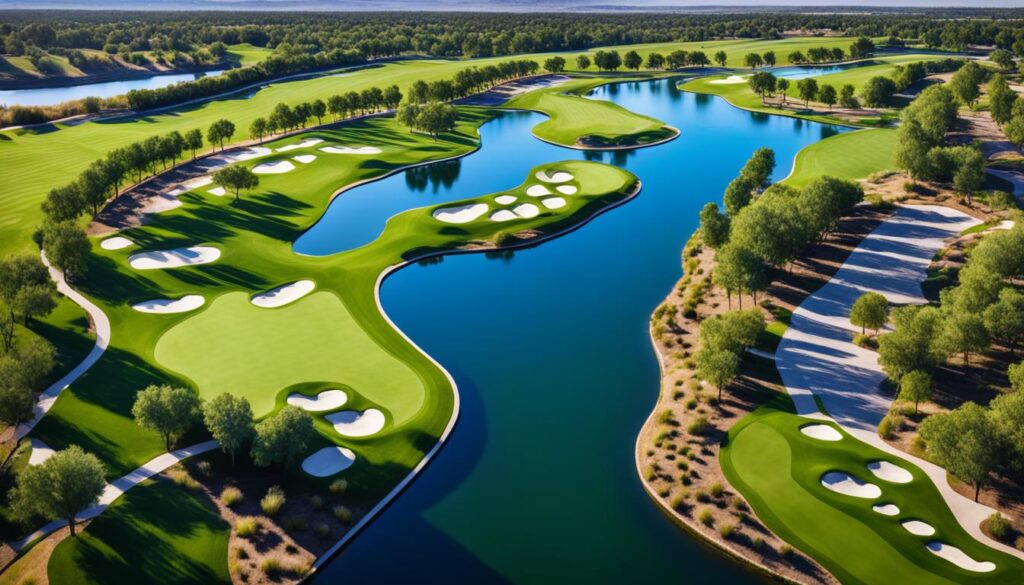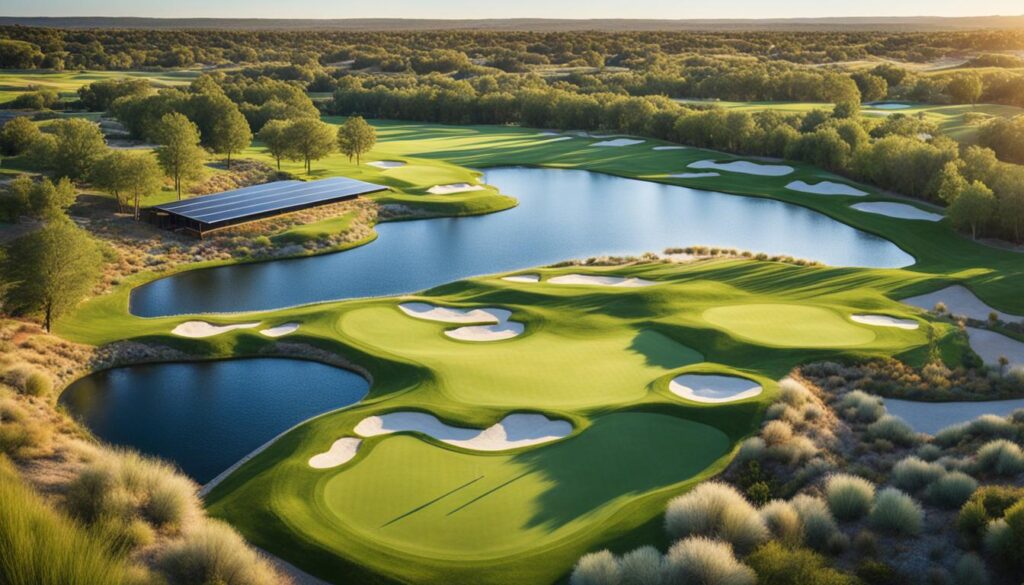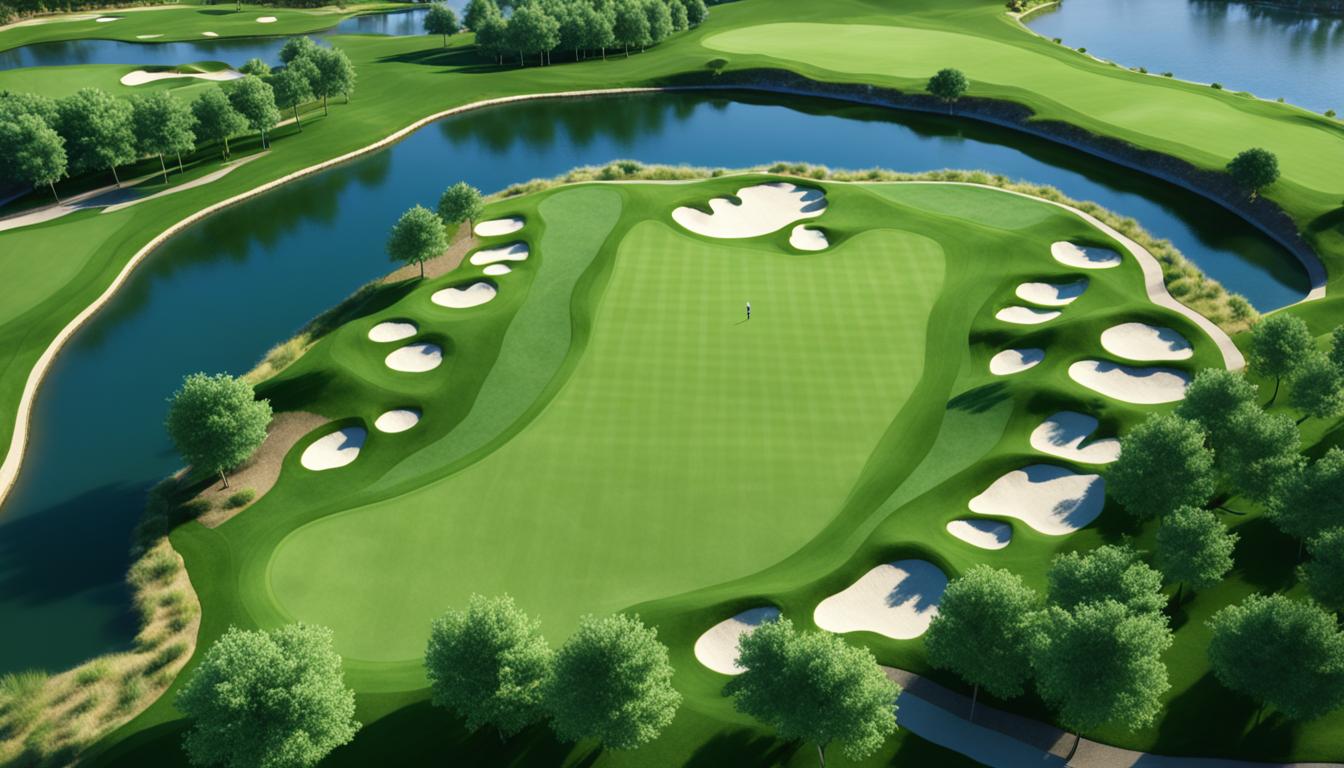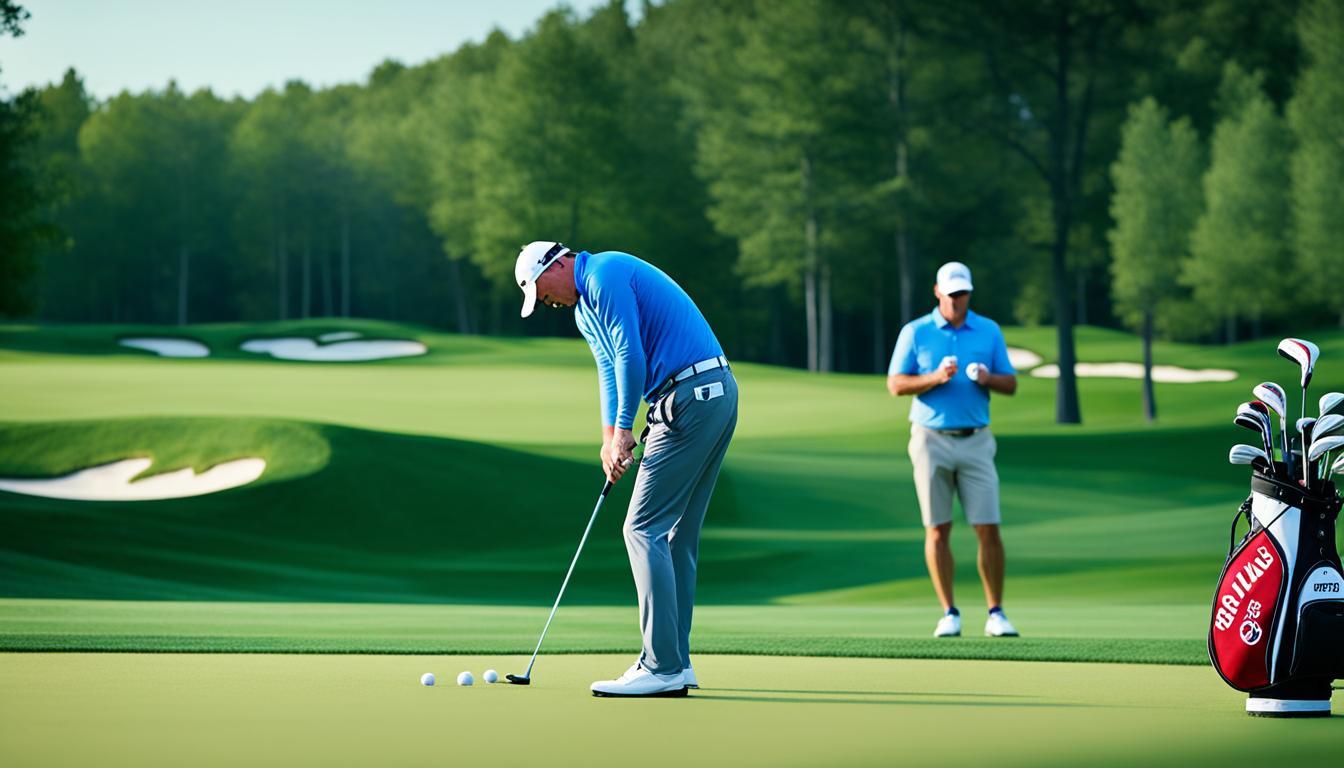Golf course design has come a long way, evolving over the years to meet changing player preferences, technological advancements, and environmental considerations. From historic courses that have shaped the game to modern trends and innovations, the design of golf courses continues to evolve, creating memorable experiences for players of all levels.
In this article, we will explore the history of golf course design, from its early beginnings to the influential architects who have shaped the industry. We will also delve into modern trends and innovations, such as sustainable development and the integration of technology. Finally, we will take a glimpse into the future of golf course design, where advancements in technology and a focus on enhancing the player experience will shape upcoming designs.
Key Takeaways:
- Historic golf courses like St. Andrews and Augusta National have set the standard for golf course design.
- Influential architects like Old Tom Morris and Alister MacKenzie have made significant contributions to the evolution of golf courses.
- Modern trends include sustainability, technology integration, and creating unique features within the course.
- Golf course layouts have evolved to provide more challenge and accommodate advancements in golf technology.
- Sustainable golf course development focuses on preserving the natural environment and minimizing resource impact.
Influential Historic Golf Course Designs
Many historic golf course designs have left a lasting impact on the game. Courses like St. Andrews in Scotland, Augusta National in the United States, and Royal Melbourne in Australia are considered iconic and have set the standard for golf course design. Architects like Old Tom Morris, Alister MacKenzie, and Donald Ross have made significant contributions to the evolution of golf course design through their innovative designs and strategic layouts.
“Golf should be played in beautiful surroundings, and the courses should be designed to blend with the natural features of the landscape,” said renowned architect Alister MacKenzie.
Old Tom Morris, also known as the “Grandfather of Golf,” played a pivotal role in the development of golf course architecture. He was responsible for the design of courses like St. Andrews, Prestwick, and Muirfield, which are revered for their classic layout and challenging features.
Alister MacKenzie, famous for his work on Augusta National, incorporated his philosophy of strategic golf course design that emphasized the importance of shot values, risk-reward options, and aesthetic appeal. His designs took inspiration from the natural landscape, using undulating terrain and strategic bunkering to create memorable golfing experiences.
Donald Ross, another influential architect, designed over 400 golf courses in North America. His designs focused on incorporating natural elements and challenging features. Ross’ courses, such as Pinehurst No. 2 and Oakland Hills, are known for their intricate green complexes and strategic placement of hazards.
Influential Historic Golf Courses
| Course | Location | Architect |
|---|---|---|
| St. Andrews | Scotland | Old Tom Morris |
| Augusta National | United States | Alister MacKenzie |
| Royal Melbourne | Australia | Alister MacKenzie |
| Pinehurst No. 2 | United States | Donald Ross |
| Muirfield | Scotland | Old Tom Morris |
These historic golf course designs continue to inspire and shape the golfing world today. Their influence can be seen in modern golf course trends and the work of contemporary architects who strive to create exceptional golfing experiences.
Modern Golf Course Trends and Innovations
In recent years, golf course design has undergone remarkable transformations, embracing sustainable practices and incorporating innovative features. Our commitment to both the environment and providing an unparalleled player experience has led to the emergence of several modern golf course trends and groundbreaking innovations.
Sustainability and Environmental Considerations
One of the most significant trends in modern golf course design is the integration of sustainable practices and environmental considerations. Courses are now meticulously planned to minimize their ecological footprint, creating harmonious landscapes that embrace native vegetation and natural water features.
By utilizing eco-friendly practices such as proper drainage systems, water conservation techniques, and efficient irrigation methods, golf courses are able to conserve precious resources and maintain healthy ecosystems. The incorporation of renewable energy sources, such as solar panels, is also becoming increasingly common to reduce the environmental impact of course operations.
Technological Advancements for Enhanced Player Experience
Technology has played a transformative role in modern golf course design, revolutionizing the way players navigate and enjoy their rounds. GPS systems and interactive course maps are now commonplace, providing golfers with precise yardages, course layouts, and real-time data on hazards and fairways. This technology not only enhances the player’s understanding of the course but also speeds up play and improves overall accuracy.
Additionally, advancements in digital scoring systems and tee time booking platforms have simplified the administrative aspects of golf, allowing golfers to focus more on the game and less on logistics. Integration with mobile applications and wearable devices further enhances the overall experience, enabling golfers to track their performance, analyze statistics, and connect with other players.
Innovative Features that Create Memorable Experiences
Modern golf course design aims to create distinctive and unforgettable experiences for golfers. As a result, innovative features have become a cornerstone of contemporary course layouts.
Island greens, for example, are becoming increasingly popular, providing an exciting challenge and breathtaking aesthetics. These greens, surrounded by water hazards, demand precision and strategic shot-making, testing even the most seasoned golfers.
Natural hazards, such as strategically placed bunkers and water elements, add both visual interest and strategic complexity to the game. By integrating these elements seamlessly into the landscape, golf course designers create strategic options and elevate the overall course experience.
Furthermore, forward-thinking architects are incorporating multi-functional spaces within the course to cater to the diverse needs and preferences of golfers. These spaces can include practice areas, fitness facilities, and even dining options, enriching the overall golfing experience and encouraging social interaction.

As golf continues to evolve, modern golf course design trends and innovative features will continue to push the boundaries of what is possible. Sustainability, technological advancements, and unique features will redefine the golfing experience and create unforgettable moments for players of all levels.
The Evolution of Golf Course Layouts
The layout of golf courses has undergone significant transformations throughout the years, reflecting changes in golf strategies and player preferences. Traditional golf course layouts were characterized by straight fairways, parallel holes, and small greens. However, modern golf course designs have embraced a more diverse approach, incorporating varied hole shapes, undulating fairways, and larger greens.
By deviating from traditional straight lines and incorporating natural landforms, modern golf course layouts offer a more interesting and challenging experience for golfers. Undulating fairways provide strategic challenges, requiring players to navigate slopes and uneven lies, adding an extra layer of difficulty to their shots. Larger greens offer more flagstick locations, increasing the variety of pin positions and requiring golfers to develop a wider range of putting skills.
This evolution in golf course layout not only enhances the overall playing experience but also aligns with advancements in technology and equipment. The golf industry has witnessed innovations in club technology, with drivers that allow golfers to hit the ball longer and more accurately. This shift in equipment has prompted golf course designers to create layouts that accommodate these improvements, providing ample landing areas and strategic options for players to optimize their performance.
Emerging Trends in Golf Course Layouts
As golf course design continues to evolve, several emerging trends are shaping the future of golf course layouts:
- Strategic Bunkering: Golf course architects are strategically placing bunkers to challenge players’ decision-making and shot placement, adding an element of risk-reward to each hole.
- Multiple Tee Boxes: Offering multiple tee box options allows golfers of all skill levels to enjoy the course and ensures a fair and challenging experience for players at different proficiency levels.
- Mixed-use Facilities: In response to changing demographics and evolving golfing preferences, some golf courses are incorporating mixed-use facilities such as practice areas, short courses, and entertainment amenities to attract a wider audience.
“The evolution of golf course layouts reflects a desire to create a more engaging and inclusive experience for golfers, while adapting to advancements in technology and equipment.” – Golf Course Architect
| Golf Course Layout Evolution | Modern Golf Course Trends |
|---|---|
| Straight fairways | Varied hole shapes |
| Parallel holes | Undulating fairways |
| Small greens | Larger greens |
Sustainable Golf Course Development
Sustainable golf course development is a vital aspect of shaping the future of the sport. With an increasing emphasis on environmental responsibility, golf courses are adopting practices that minimize the impact on natural resources. By integrating sustainable principles into their design and maintenance, golf courses can preserve the natural beauty of the surrounding landscape while ensuring their long-term viability.
One key element of sustainable golf course development is careful land planning. By considering the unique characteristics of the site, including topography, vegetation, and wildlife, golf course architects can create layouts that harmonize with the natural environment. This approach not only enhances the overall aesthetics but also minimizes disruption to ecosystems and reduces the need for extensive land modifications.
Water conservation efforts play a crucial role in sustainable golf course development. From implementing efficient irrigation systems to incorporating natural water features, such as wetlands or ponds, golf courses can reduce their reliance on freshwater sources. By using recycled or rainwater for irrigation and strategically managing water usage, courses can contribute to water conservation efforts and minimize their impact on local water resources.
Another important aspect of sustainable development is the use of environmentally friendly materials. From selecting grass varieties that require less water and maintenance to using eco-friendly fertilizers and pest control practices, golf courses can reduce their ecological footprint. By prioritizing sustainable materials and techniques, courses can operate in a more environmentally responsible manner without compromising the playing experience.
Benefits of Sustainable Golf Course Development
Sustainable golf course development offers numerous benefits, both for the environment and the golfing community. By preserving and enhancing the natural surroundings, golf courses create stunning landscapes that attract players and visitors alike. The integration of sustainable features not only supports local ecosystems and biodiversity but also provides educational opportunities for golfers to learn about environmental conservation.
“Sustainable golf course development preserves the natural beauty of the surrounding landscape, minimizes resource consumption, and contributes to the long-term success of the golf course.”
Moreover, sustainable practices can lead to cost savings for golf courses in the long run. By reducing water consumption, managing energy usage, and implementing efficient maintenance strategies, courses can lower operational expenses while contributing to a more sustainable future.
Sustainable golf course management and development are essential for ensuring the long-term success and enjoyment of the sport. By embracing practices that prioritize environmental sustainability, golf courses can preserve natural resources, support local ecosystems, and provide players with memorable experiences. This commitment to sustainability not only benefits the golfing community but also ensures a healthier planet for future generations to enjoy.

The Future of Golf Course Design
The future of golf course design holds great potential for further innovation and advancements. As technology continues to evolve, golf course architects may incorporate virtual reality and artificial intelligence into the design process. This will revolutionize how courses are conceptualized, allowing designers to create immersive experiences and visualize the potential of a course before construction even begins.
There is also a growing emphasis on enhancing the overall experience for golfers. In addition to designing challenging and aesthetically pleasing courses, architects are incorporating wellness amenities to promote relaxation and rejuvenation. From on-site spas and fitness centers to meditation areas, these amenities will cater to the holistic well-being of golfers and create a more fulfilling experience.
The future of golf course design will also prioritize interactive elements and multi-functional spaces. Imagine a course where players can compete against virtual opponents or participate in simulated historic tournaments. Additionally, golf courses of the future may feature multi-functional spaces that can be adapted for various events such as weddings, corporate outings, and community gatherings. This adaptability will ensure that golf courses remain vibrant and relevant, serving as dynamic hubs that cater to diverse needs.
Addressing the needs of new generations and adapting to changing demographics will be crucial in shaping the future of golf course design. The golfing community is becoming more diverse, with a greater representation of women, younger players, and families. To engage these new audiences, golf courses will need to offer more family-friendly facilities, such as playgrounds and childcare services, and provide engaging experiences that cater to different skill levels and interests.
With a focus on sustainability, innovation, and creating memorable experiences, the future of golf course design is poised to be exciting and transformative. By embracing emerging technologies, enhancing golfer experiences, and adapting to evolving demographics, golf courses will continue to be cherished spaces that inspire and captivate players for generations to come.
FAQ
How has golf course design evolved over the years?
Golf course design has evolved significantly over the years, with changes in architecture, layout, and features. From the historic courses to modern trends, influential architects have shaped the way golf courses are designed today.
Which historic golf course designs have had a lasting impact on the game?
Iconic courses like St. Andrews in Scotland, Augusta National in the United States, and Royal Melbourne in Australia are considered historic and have set the standard for golf course design. Architects like Old Tom Morris, Alister MacKenzie, and Donald Ross have made significant contributions to the evolution of golf course design through their innovative designs and strategic layouts.
What are some modern trends and innovations in golf course design?
Modern golf course designs now include sustainability and incorporate innovative features. Courses are designed with environmental considerations in mind, using native vegetation, natural water features, and eco-friendly practices. Other trends include the integration of technology and creating unique features within the course, such as island greens, natural hazards, and strategic bunkering.
How have golf course layouts changed over time?
Traditional golf course layouts were characterized by straight fairways, parallel holes, and small greens. However, modern designs now feature more varied hole shapes, undulating fairways, and larger greens. This evolution in layout aims to provide a more interesting and challenging experience for golfers, as well as accommodating advancements in golf technology and equipment.
What is sustainable golf course development?
Sustainable golf course development involves careful land planning, water conservation efforts, and the use of environmentally friendly materials. These practices preserve the natural beauty of the landscape and contribute to the long-term viability and success of the golf course.
What does the future hold for golf course design?
The future of golf course design holds great potential for further innovation and advancements. Virtual reality and artificial intelligence may be incorporated into the design process, and there is a growing emphasis on enhancing the overall experience for golfers through wellness amenities, interactive elements, and multi-functional spaces. Addressing the needs of new generations and changing demographics will also shape the future of golf course design.



